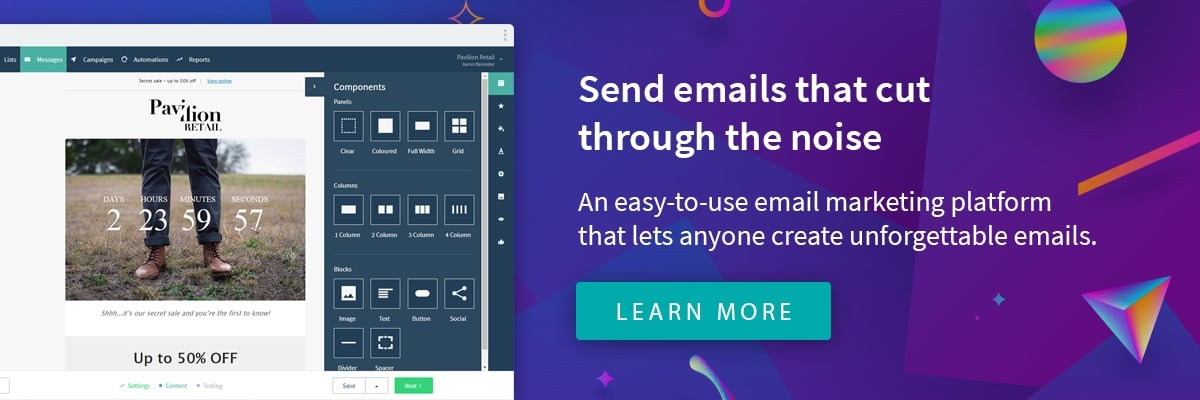Email is still the cornerstone of the digital age, and while marketing via email may have evolved, it is still a powerful way to sell your product or brand. Why? Because email takes your message and puts it directly into an individual’s inbox, making it much more personal than a Tweet that goes out to thousands of followers.
Email is the perfect way to connect with consumers through personalised messages. Always keep in mind what Don Draper stated in the very first episode of Mad Men: “Advertising is based on one thing: happiness.” It’s critical to use email marketing strategies that invoke positive emotions.
In this blog, we’re going to cover three broad strategies you can implement today to spark positive emotion with email.
1. Ignite temptation and intrigue through simple trigger emails
Creating curious customers isn’t rocket science. Here’s one method in action:
“Do you want to know the number one way to get customers to open an email from you?”
It’s that simple. Pique your customers’ curiosity, just like I did with the above question. Curiosity stimulates the dopamine reward center, making it a powerful, positive emotion. Ignite curiosity by constructing intriguing subject lines. “Want to know how to get more out of your (insert product or service here)?” compels your reader to open the email because of course they want to get the most out of what they have paid for. Intriguing subject lines are short, individualized, and specific.
Sending a trigger email – an email that responds to subscriber engagement – is also an effective email marketing tool for creating temptation and intrigue. (Reminders, confirmation notices, and re-engagement messages are all examples of trigger emails.)
Abandoned basket emails are especially effective because they remind prospects to purchase items or services you already know they desire. “Hurry! There are only a few [item name] remaining!” puts pressure on the customer to make that purchase, and to make it quick.
Urgency aside, if some time has passed and a prospect hasn’t completed their purchase, a friendly reminder that they have items waiting for them is incredibly tempting.
2. Spark excitement in your brand by making customers feel special
Everyone likes to be singled out and made to feel important. Making your customers feel special fosters loyalty in your brand, and loyalty is the main reason your customers return to you, even when prices are lower elsewhere. A prospect is much more likely to open an email if it addresses them as a VIP, and there are a myriad of ways to make an individual customer feel important.
Emails can offer pre-launch sales, special offers that come with membership programs, reward programs, and special limited-time offers for valued customers. A limited-time offer not only invokes temptation, but gives the customer the opportunity to feel special, because they are one of the few to nab a specific service or product.
For example, online retailer ASOS use this personalised special offer to brilliant effect during the Christmas period:

Fast and personalised customer service impresses and makes customers feel appreciated. Send emails that address their specific concerns and provide tailored solutions. Offering more than one solution gives your customers even more control and makes them feel valued.
Saying you desire customer satisfaction is one thing; following through on making sure they are satisfied is a way to build trust and loyalty.
3. Inspire confidence by sending informative emails
Information is what satisfies curiosity. Informed people feel in control and confident, two positive traits that will compel people to invest in your brand. Never underestimate that value of great content! Email provides a better platform for quality content than Facebook or Twitter.
Informative emails contain highly relevant and reassuring content. Your informative email may contain general news about your brand, technical news, information about upcoming events, trade shows, and even simpler content like the location of stores and the times that they are open.
For example, after a visit to Easyjet.com, the company sends information about flight times, about how to find great deals, how to books hotels, and other travel advice that is useful and appreciated.
Give your customers a chance to subscribe to informative newsletters. Make them fun to read! Amusing or exciting copy captures attention and summons up those positive emotions.
Remember: knowledge inspires confidence, and if it comes free via an email? All the better! If your emails come across as perks, they are more likely to be read, and the chances of selling your goods or services increases significantly.
Conclusion
Email marketing works when it is personalised. Use email marketing opportunities to sell intrigue, excitement, and confidence through individualized messages. If you make selling these emotions your goal, promoting your products and services becomes a secondary objective that won’t require extra work, as your brand has already become inextricably tied to feelings of happiness. And happiness is what sells!

